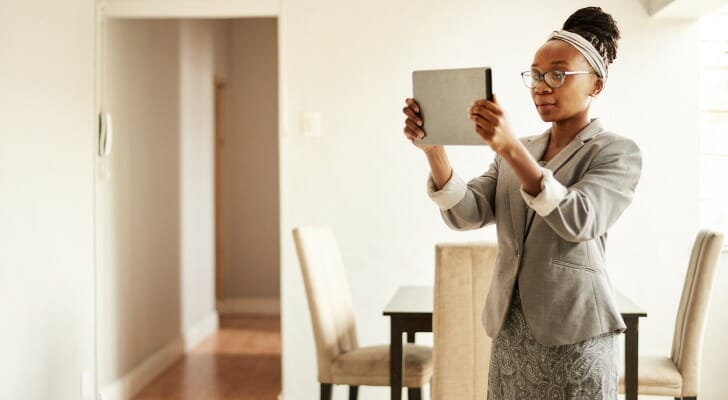With preapproval, attending showings, committing to a down payment and engaging in bidding wars, buying a home can be arduous. If you have made it to the final walkthrough, congratulations! The final walkthrough is a crucial step where you check the condition of the home and address last-minute problems. If you’re worried about the final walkthrough, that’s entirely normal. This guide provides a checklist for the final walkthrough before closing to help you navigate the process without missing a beat.
You may want to also work with a financial advisor who can help you prepare for a mortgage or how your new real estate investment will play into your full financial plan.
What Is a Final Walkthrough?
Whether you’re buying your first home or your last, a final walkthrough during a real estate transaction is a buyer’s last opportunity to check the condition of the home being bought. Ideally, in a final walkthrough, it will be verified that:
- The repairs you agreed on with the seller have taken place
- The property has not significantly changed since the inspection
- The seller has left all furniture and equipment as you negotiated
- Every system and appliance designated by the contract is operational
This list may seem daunting, but confirming the property’s status on the final walkthrough is essential. New or previously undiscovered damage sometimes pops up on the final walkthrough, and you owe it to yourself to be thorough.
It’s a good idea to have the final walkthrough one or two days before closing. Otherwise, the elapsed time is an opportunity for more changes to occur in the home. Also, during the walkthrough, the house should be bare. If the seller still has furniture or other items in the home, they can hide damage or otherwise obstruct your walkthrough.
The buyer and buyer’s real estate agent must attend the final walkthrough. The buyer’s home inspector or the professionals who fixed anything in the house may also be present if the buyer wishes.
What Should Buyers Bring to a Final Walkthrough?
A number of items can help you during your final walkthrough. Use the following list to ensure your walkthrough is as thorough and productive as possible.
- Your offer on the home: This document contains all repairs and other conditions you and the seller agreed upon.
- The home inspection results: You can compare the inspector’s report with the present condition of the home and confirm that the seller has completed the repairs recommended on the report (if that was agreed to).
- Any additional documents, like the final contract: These contain agreements between you and the seller regarding repairs. This can include the closing disclosure so you know what the seller has already disclosed if anything.
- A notebook: You can jot down notes as you conduct the walkthrough and ensure you don’t forget that dead outlet you discovered when you first walked in.
- A phone or camera: If there are signs of damage or other concerns in the walkthrough, taking photos of everything is crucial to show the seller later.
- A phone charger: This will ensure that while you’re taking photos or communicating, your phone doesn’t die. Additionally, you can test all outlets in the home with it.
- Your checklist: It won’t do you much good sitting on the kitchen counter at home!
What to Look for During a Final Walkthrough

The final walkthrough is not a time to explore every nook and cranny of the home – that’s what a home inspection is for. Instead, the final walkthrough is a general check that the home is in the condition the seller guaranteed before closing. Doing the following eight things can help you feel satisfied with your final walkthrough:
1. Identify Repairs
Any repairs the seller committed to should be complete by this time. Additionally, it’s a good idea to gather receipts and any warranties from the repairs in case you need to follow up with the professional or business that did the work.
2. Check for Sale Items
Your purchase agreement with the seller dictates what is left in the home. In the final walkthrough, you can verify that all items, from appliances to curtains, are in their proper place. Additionally, the property should contain no trash, wreckage or other remains from recent repairs.
3. Open Doors and Windows
Security is a top priority for any new homeowner. Windows and doors should open and close properly as well as lock. In addition, window screens should be in place as needed. If any of them don’t open or close fully or are broken, they might present a fire hazard.
4. Inspect Bathrooms and Kitchen
Check the bathrooms for stagnant water by the toilet, shower and sink. Water damage or mold may have appeared since the inspection. Test each water outlet for leaks, correct drainage and hot water. The same goes for the kitchen. After checking the sink, inspect the other appliances (refrigerator, dishwasher, etc.) for water damage and leaks as well.
5. Test Appliances, Heating and Cooling Systems
After checking kitchen appliances for water-related issues, you can test the other appliances. For example, put the dishwasher on and see if the oven heats properly. A lingering scent of gas can indicate a serious problem.
From there, the washer, dryer and other appliances should turn on and function normally. Then, activate the air conditioning and heat, no matter how cold or hot it is outside. Your air conditioner and furnace are essential throughout the year, so turning on the air for a second is crucial, even if it’s icy cold outside.
6. Look Out for Pests
Some houses sit vacant for a while after the seller moves out, allowing pests to move in before you. Animal droppings and carcasses can indicate a burgeoning rodent problem. Also, disintegrating wood, mushy floors and dry rot imply the presence of ants and other unwelcome creatures.
7. Test Electrical
Use your phone charger on the outlets in each room as you go through it. Flip the light switches as you progress as well. After checking these, test the garage doors, doorbells and security cameras. Any electrical troubles could point to an issue that needs addressing before closing day.
8. Walk Around the Property
You’ll want to walk around the property and inspect the home’s exterior, backyard and lawn. If your property has a pool, check for mold, mildew or damage to the lining. If your home has an irrigation system, check to see if it works by turning it on and off. Upon inspection of the exterior of your new home, make a list of any damages or actionable items you need to tend to when you move in.
What Is the Seller’s Role in the Final Walkthrough?
The seller should not be present at the final walkthrough. However, the residence should be left “broom clean” only the items listed on the sales agreement should remain behind. Additionally, the seller should verify the completion of any necessary repairs before you move in.
What to Do If an Issue Comes Up?
The final walkthrough is often an uneventful stroll through the rooms of your home-to-be. However, issues sometimes arise that you cannot easily fix. In this case, you have several options:
- Postpone closing until fixes and repairs address the problem.
- If you want to address the repairs on your own after closing, you can communicate with the seller and have him or her reimburse you for the associated costs.
- Walk away from the house. This is highly undesirable for all parties involved and should be your last resort. Typically, the seller will readily take care of any problems to ensure that closing occurs as scheduled or with only a short delay.
The Bottom Line

Since the final walkthrough is the final step separating you from closing, the thought of something going wrong can be stressful. However, going in prepared can help you address any challenges quickly, and the seller is as invested as you are in solving any problems. Additionally, it can be helpful to remember that most final walkthroughs bring no new issues to light. Rather, your final walkthrough is a way to practice due diligence and take another look at your new home.
Tips for Buying a Home
- Purchasing a home is a big investment, but it’s easy to run into pitfalls before closing. The guidance of a qualified financial advisor can be crucial to getting it all done right. Finding a qualified financial advisor doesn’t have to be hard. SmartAsset’s free tool matches you with up to three financial advisors who serve your area, and you can interview your advisor matches at no cost to decide which one is right for you. If you’re ready to find an advisor who can help you achieve your financial goals, get started now.
- Buying a home can be stressful, but some tools can make the process smoother. Our home-buying guide can break down the necessary steps to get you from pre-approval to closing day.
Photo credit: ©iStock.com/AJ_Watt, ©iStock.com/DjordjeDjurdjevic, ©iStock.com/AJ_Watt
